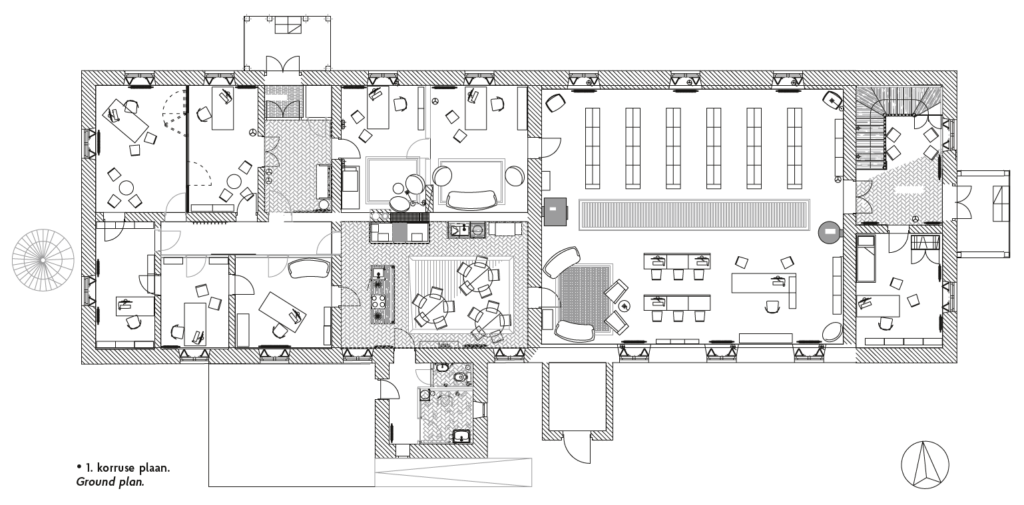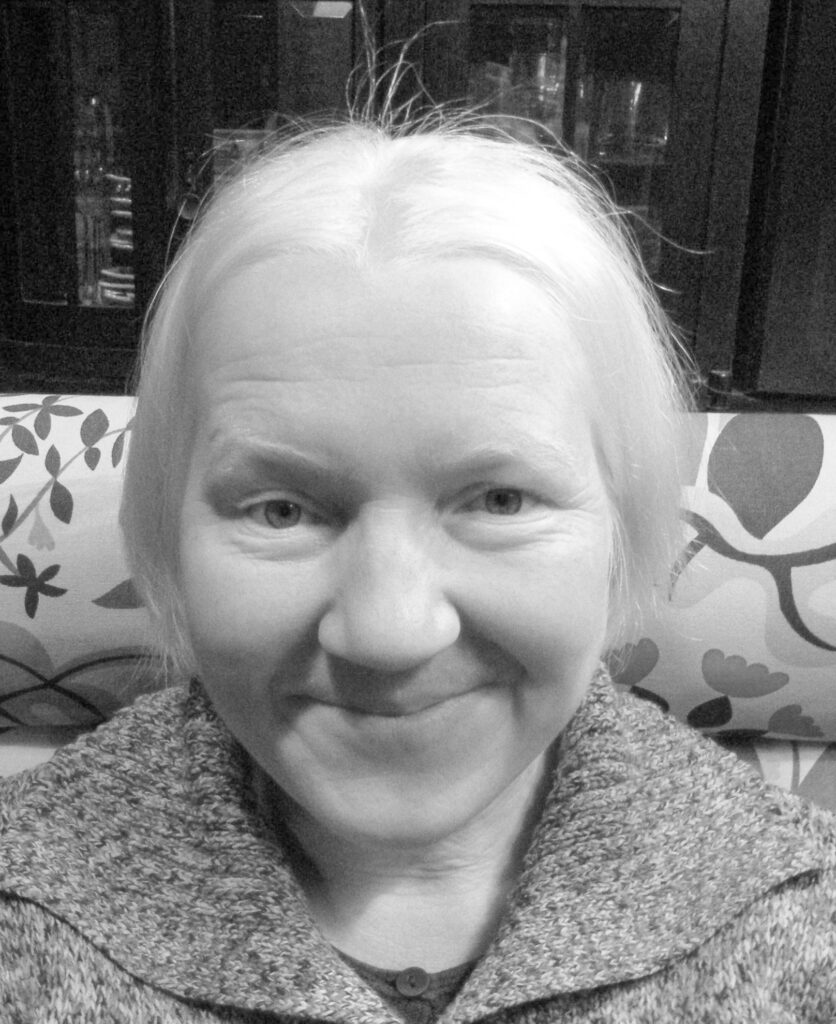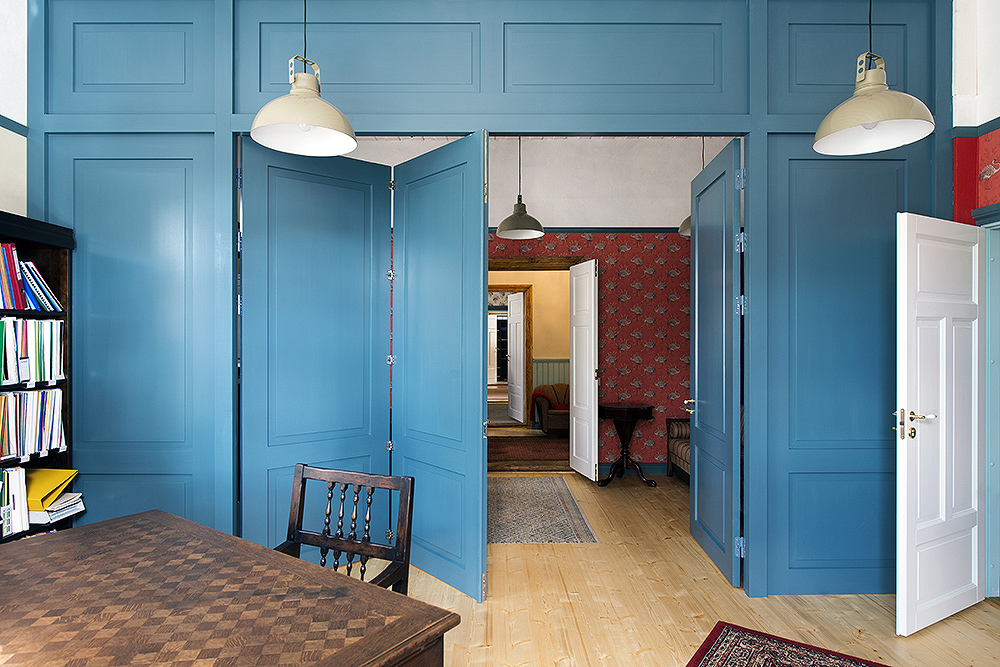KULLA CONFIRMATION HOUSE
Location: Kulla village, Mulgi municipality, Viljandimaa
Architecture: Kalle Kadalipp (VMT ehitus)
Interior architecture: Liis Tarbe
Commissioned by: Halliste vallavalitsus
Constructed by: Silindia ehitus
Building net surface area: 380m2
Project: 2015
Construction: 2017-2018
In addition to bringing together various public functions, the former Kulla confirmation house reconstructed as a library and rural municipality office also functions as a gate to the local community.
When reflecting on the confirmation house, I was first reminded of an experience from my country life ten years ago: imagine a pitch-dark November night in the Central Estonian periphery. There were no lights, it had been sleeting and the drive on the unpaved road was lumpy. In an attempt to spare my car while jigging slowly along the bleak roads amid fields and barn ruins, I came to … the local municipality office building. The building is a poorly lit postmodern white brick architectural gem. The entrance hall is bleak and chiming. The dim path on the warped stairs leads to the second floor. I open the door! … and walk into a brightly lit library filling my heart with inconceivable joy of the warmth, light, people and books. I suppose at the time my need to communicate with people and my hunger for culture outweighed the thought of spending a cosy night at my timber mansion. The library certainly satisfied also the given need despite its meagre looks and content.
Living in the country hasn’t always been the romantic private existence in the midst of nature. The daily life often stands for endless drives between the nearest town and fight against the “onslaught of nature”. The typical problems include poor road conditions, power cuts, problems with water, sewage and phone connection, not to mention the fallen trees, invasive thicket and bugs. In a word, quite physical issues! Added to that also some socio-economic concerns that rural residents must handle on daily basis (disappearance of schools, medical centres, postal services etc), it is no wonder that most people don’t even think about the possibility of libraries in the country.
Kulla confirmation house
In 1902, Halliste church commissioned the building of a new confirmation house in Kulla village about half a kilometre from the church with private quarters for the sacristan. In 1930-1998, it housed the local school and then remained empty for 14 years. In 2014, prior to the merger of rural municipalities, the local government of Halliste was searching for new premises and their eye was caught by the former confirmation building. The part to follow is reminiscent of the Cinderella tale. The story is not short of a fairy godmother either – the local enthusiast Ene Maaten who did not merely wield a magic wand but actually needed to make superhuman efforts, spending probably hundreds of hours on communicating with the architects (Kalle Kadalipp, Liis Tarbe), builders (Silindia Ehitus OÜ) and other officials as well as on searching for furniture in antique shops.

It is truly heart-warming to see a well-maintained brick house in the gorgeous snowscape and to sense the warm feel of the bright colours, old furniture, patterned wallpaper and other clever details. Just as the experience with the country library, also the given building is multifunctional – in addition to the library, the building accommodates also the rural municipality office, post office, the Institute of Mulgi Culture and in the future also the church office. The building brings together the various facets of human nature – the mundane and the poetic. For a shrinking county centre, it is both logical and rational. The only thing is that putting all activities together means that somewhere another building will be left over to perish. Similarly, other institutions such as general medical practises, retirement homes as well as shops and bakeries could be established in renovated old buildings. It is common that we tend to value buildings from the Tsarist era or the first period of Estonian independence while we overlook the more recent layers. In cooperation with architects, interior architects and landscape architects, also modernist collective farm architecture could be given a cosy contemporary and environment-friendly touch.
Taking new buildings into use again and mixing the urban lifestyle with historic rural environment provides various interesting and sometimes even humorous combinations. The most curious transformations I have come across in Estonia include a distillery turned into a meditation chapel, a Soviet country store converted into an art gallery, a morgue now housing a library and a school gym accommodating a riding ground. Against such a background, the library and municipal office in the former confirmation house is on the verge of boredom.
It seems that there is no shortage of opportunities for activity in the rural areas of Estonia, however, there is a shortage of people who would enjoy it all throughout the year. According to official records, there are less than 100 people in Kulla village (with the number of permanent residents presumably even smaller), while the former Halliste municipality included 1500 residents and the merged Mulgi municipality now has almost 8000 people. Thus, only few people have the opportunity to enjoy the harmonious idyll of the traditional architecture in harness with the modern conveniences on daily basis, however, it is indeed open to everybody and with all their heart, which we experienced in person. It functions as a kind of a gateway to the local community. In the modern society appreciative of privacy and financial gain, the preservation of such spots of “everyman’s right” is only commendable. And hopefully makes life in the country more than a mere environment permeated with rationality and functionality and provides it with possibilities for chance encounters, heated sanctuaries (churches tend to be cold, but also libraries could be taken as places of quiet contemplation) and other irrational areas (gallery, forest hut Ruupor etc).
I’m positively jealous of people who work in Kulla confirmation house as such a cosy work environment can usually be created only at home. Fortunately, we can all be proud of the building as it has received plenty of praise and recognition. We should also consider ourselves lucky that we still have people who can restore such local architectural gems as well as people who can duly appreciate it.

KADRI ROOSI is a graduate of the department of architecture and urban design of EAA working now as a freelance illustrator.
HEADER: Kulla confirmation house. Photo by Terje Ugandi.
PUBLISHED: Maja 99 (winter 2020) with main topic Rural Insights








